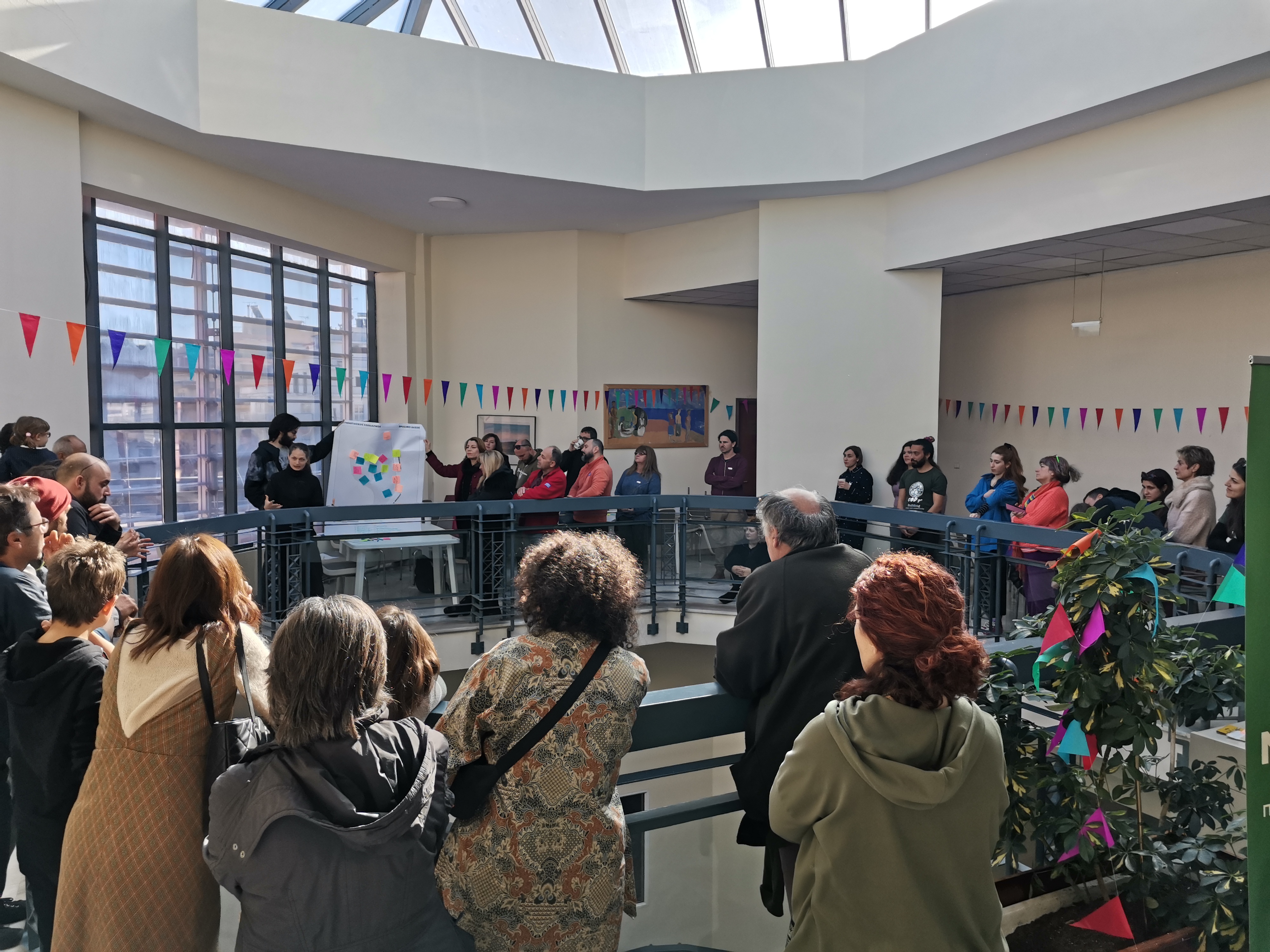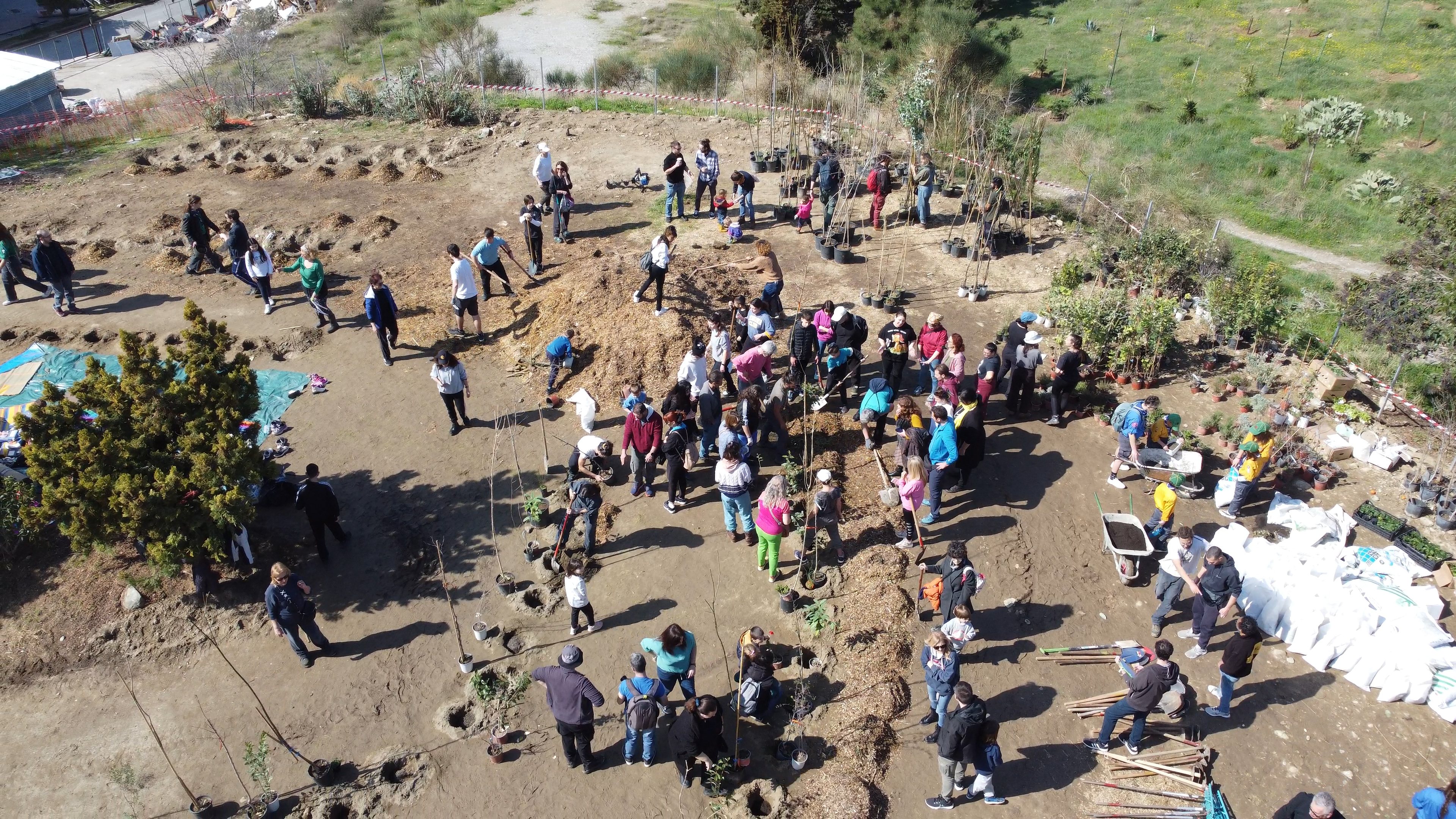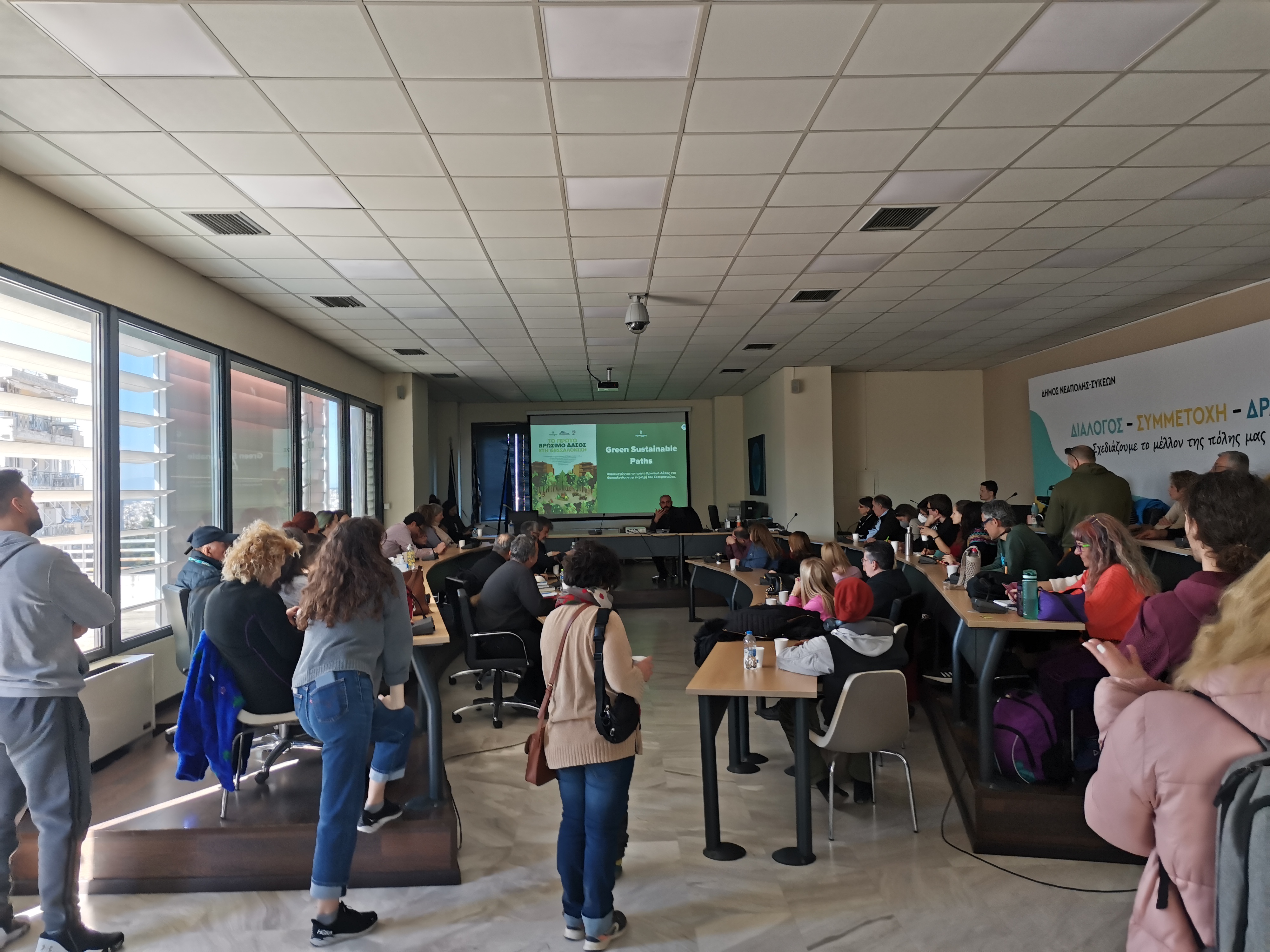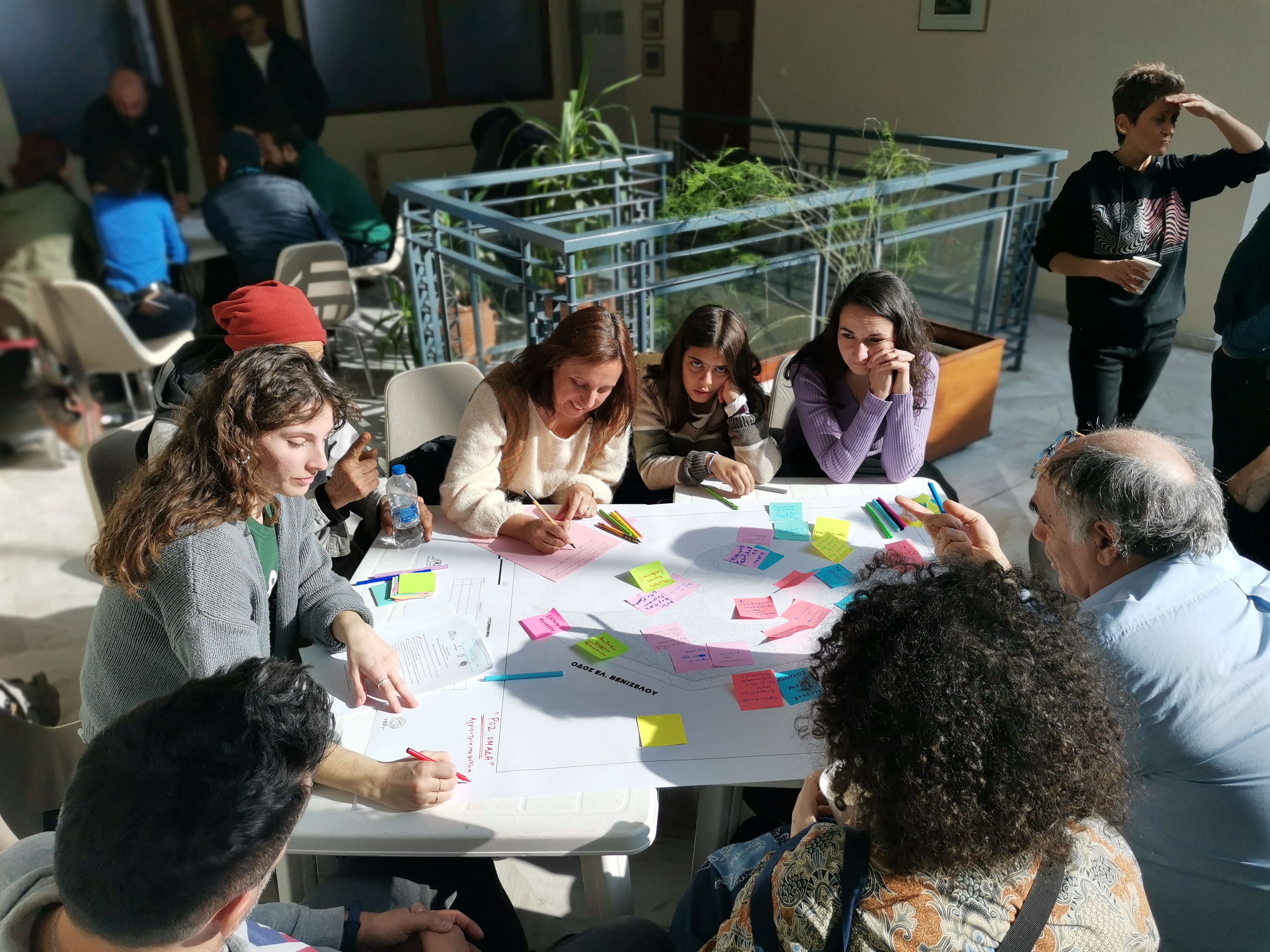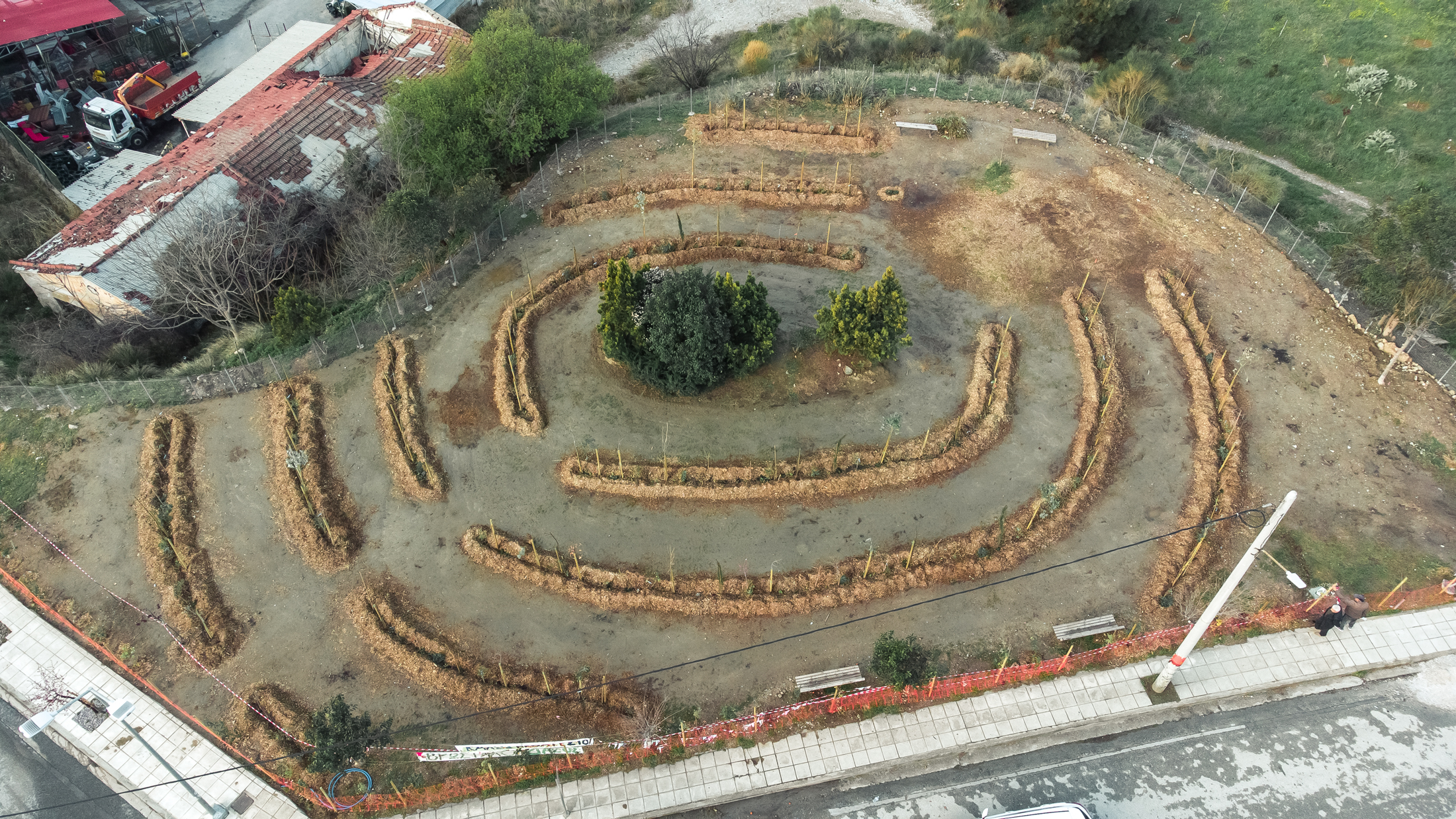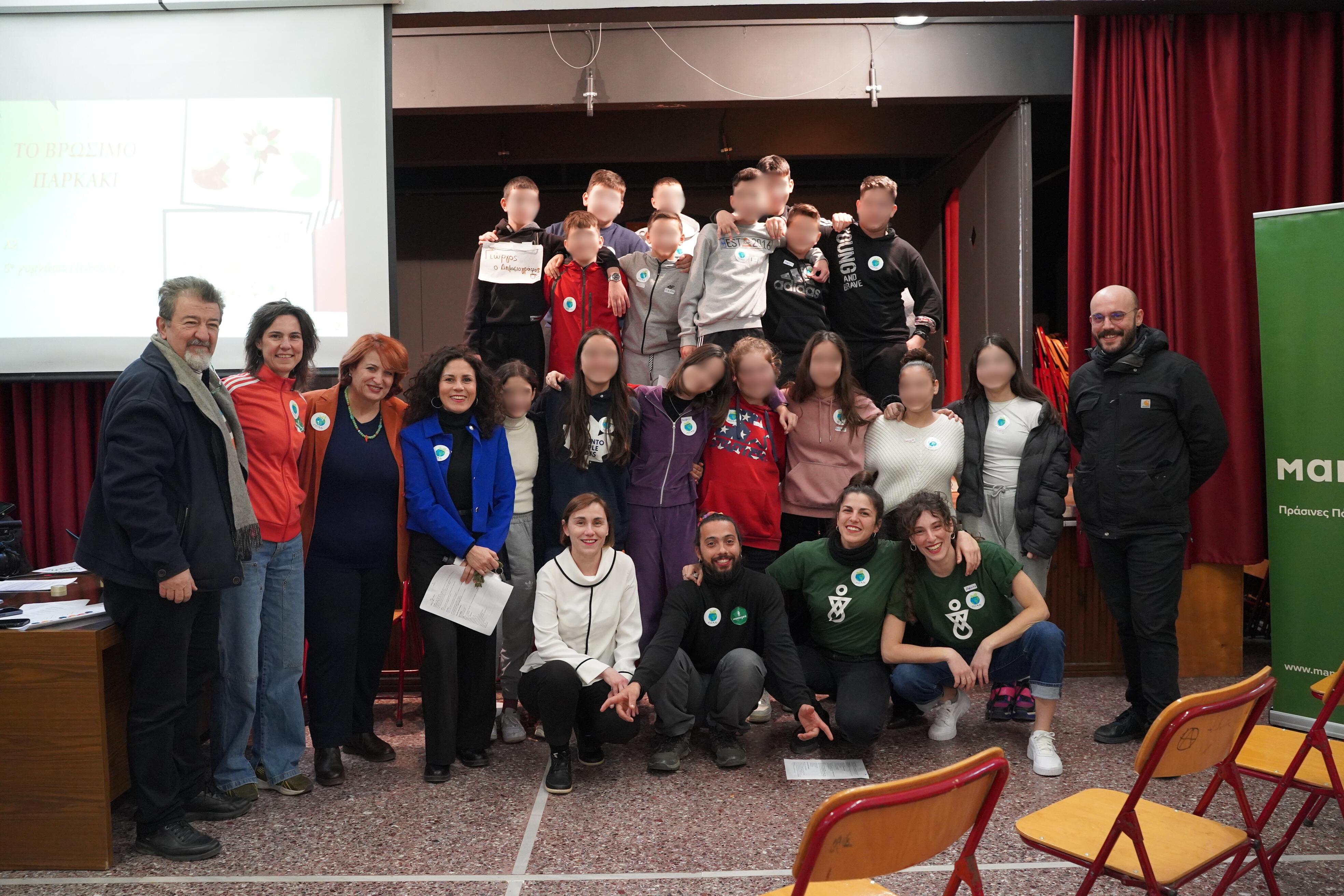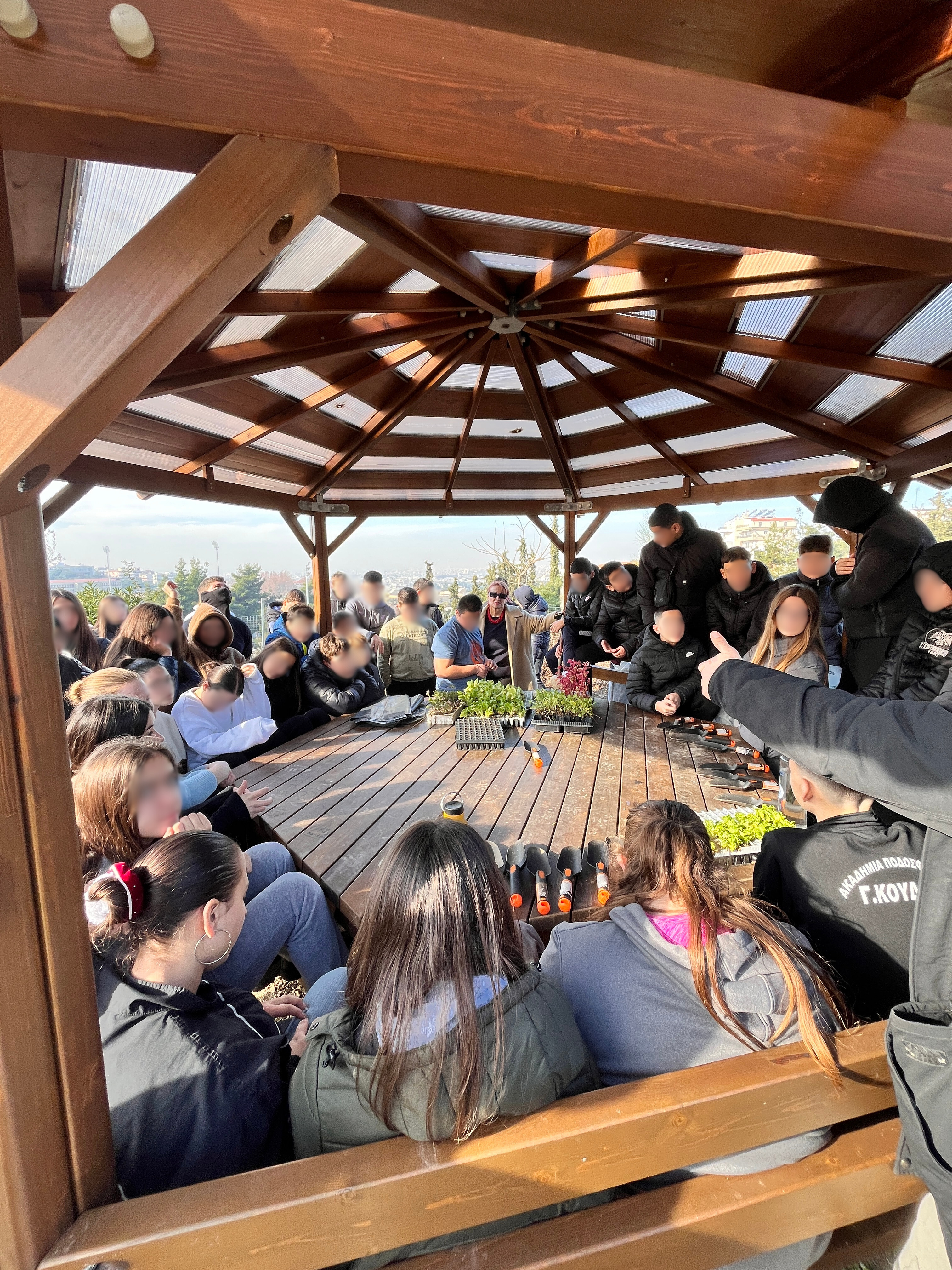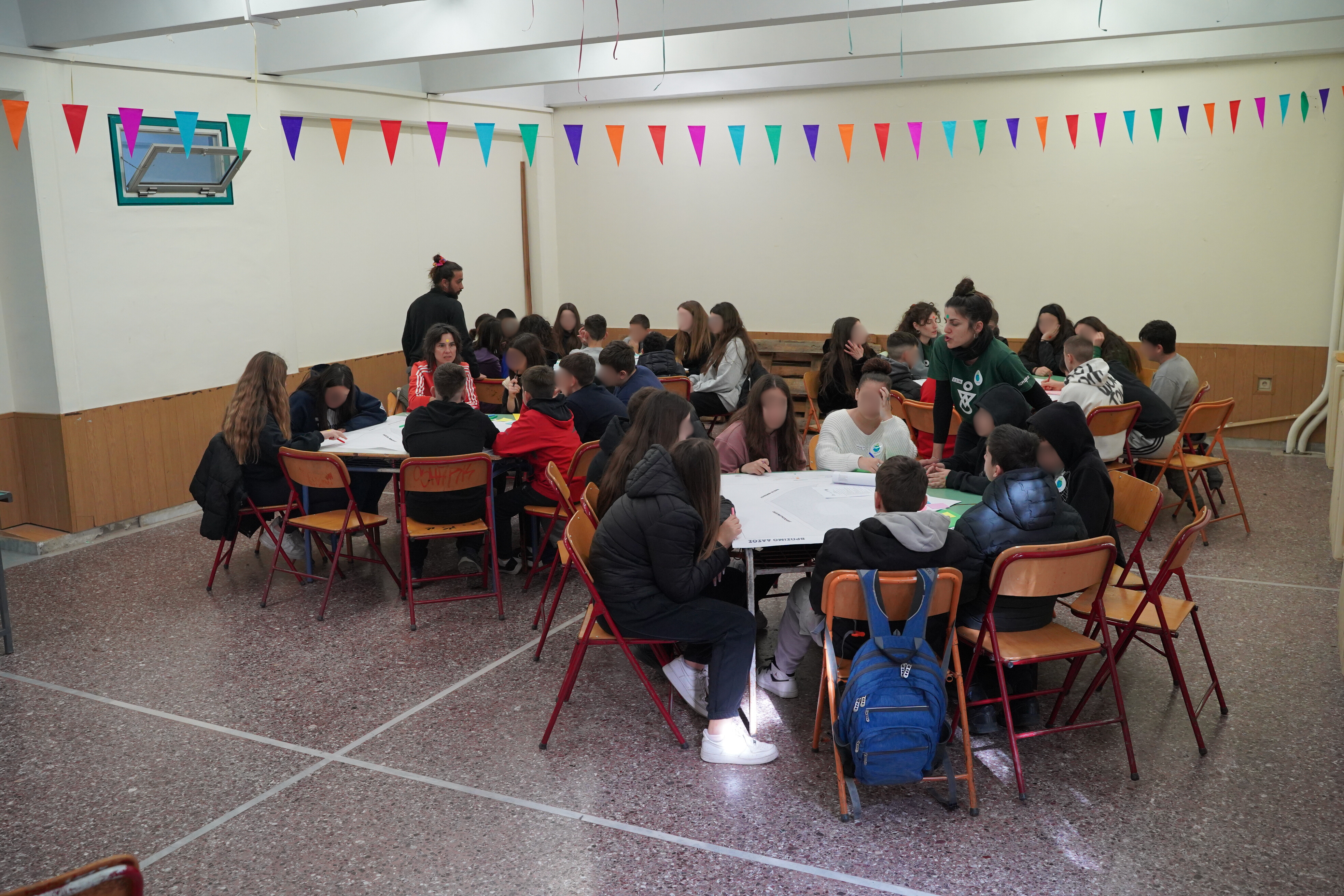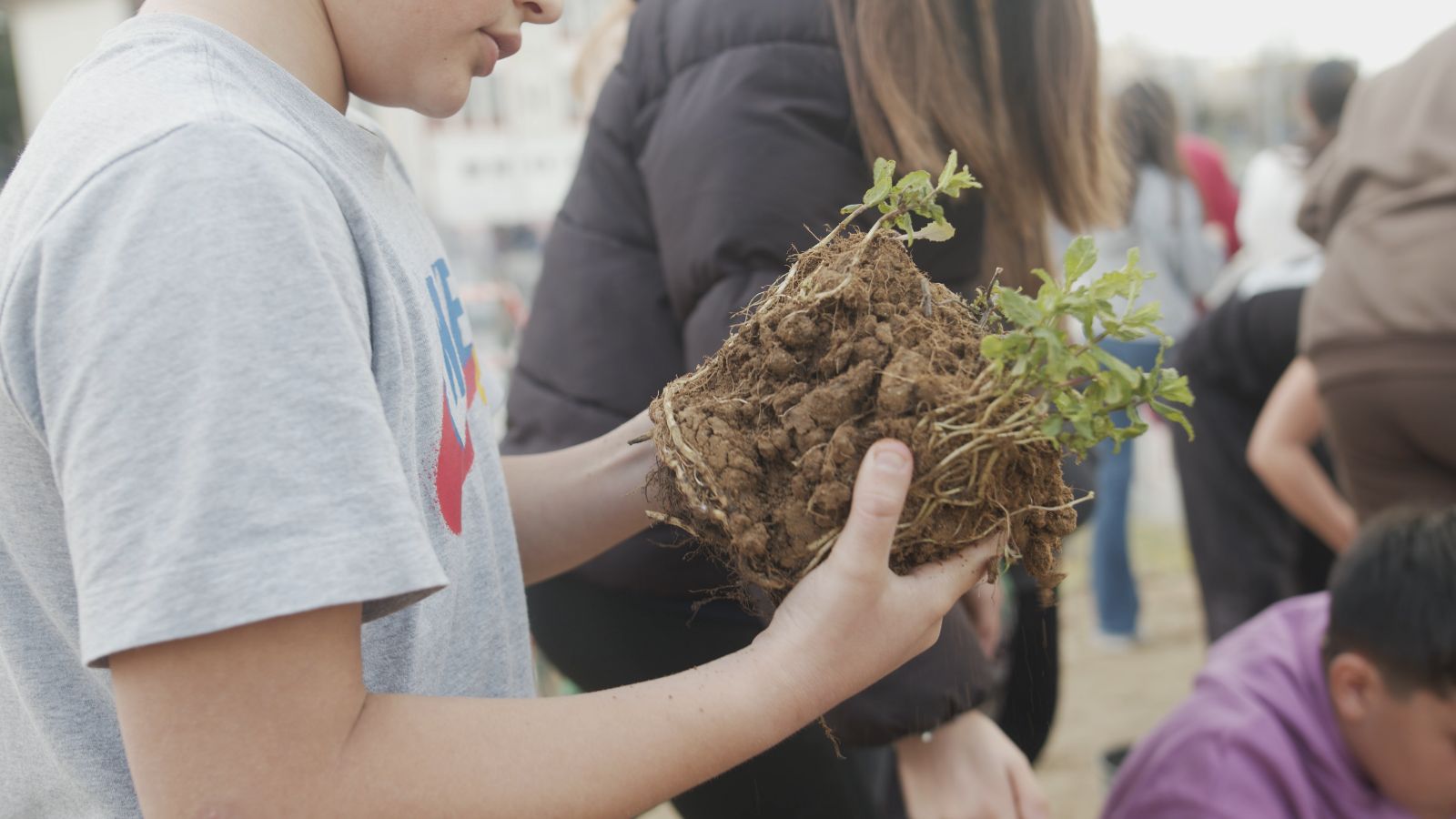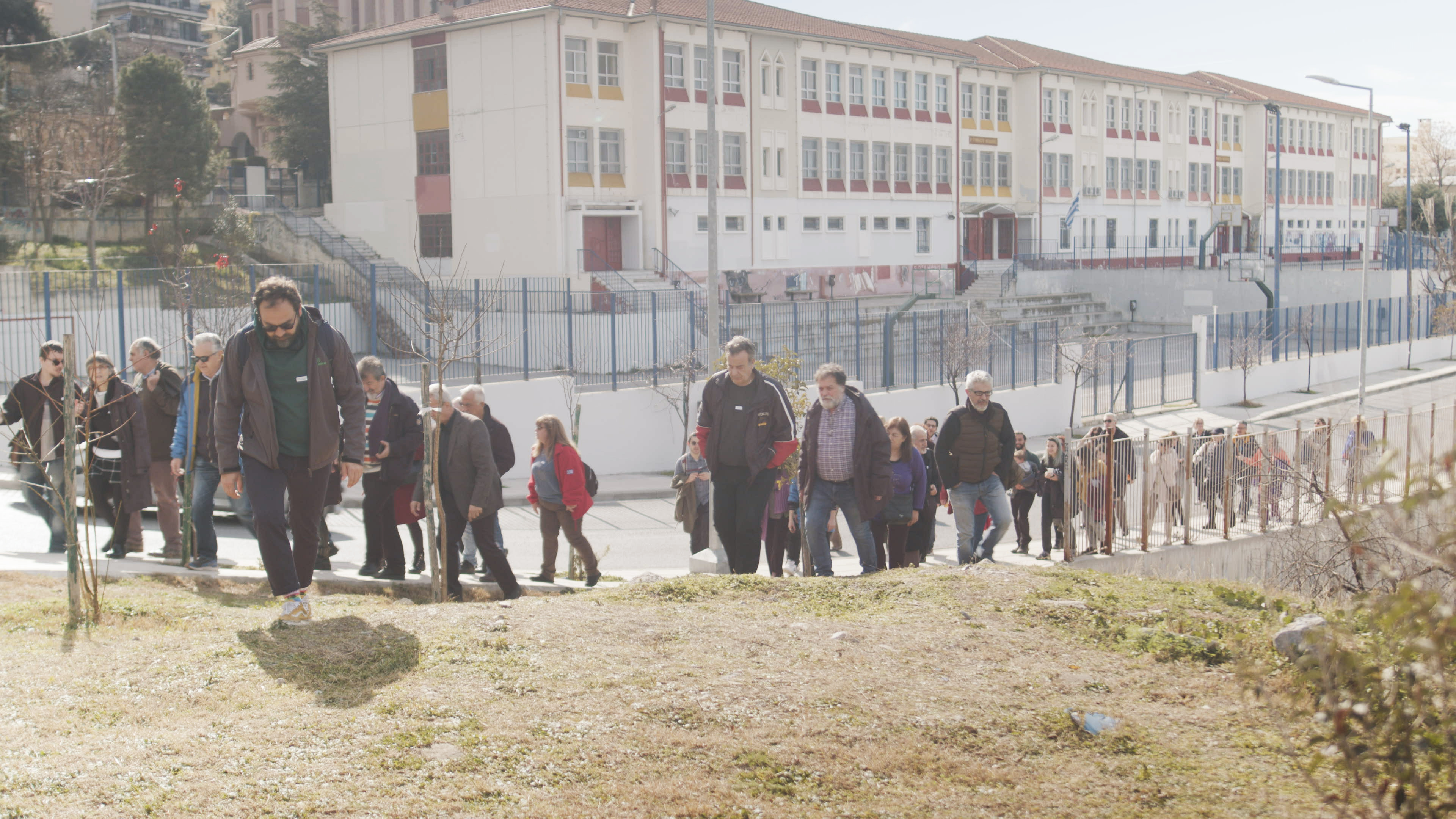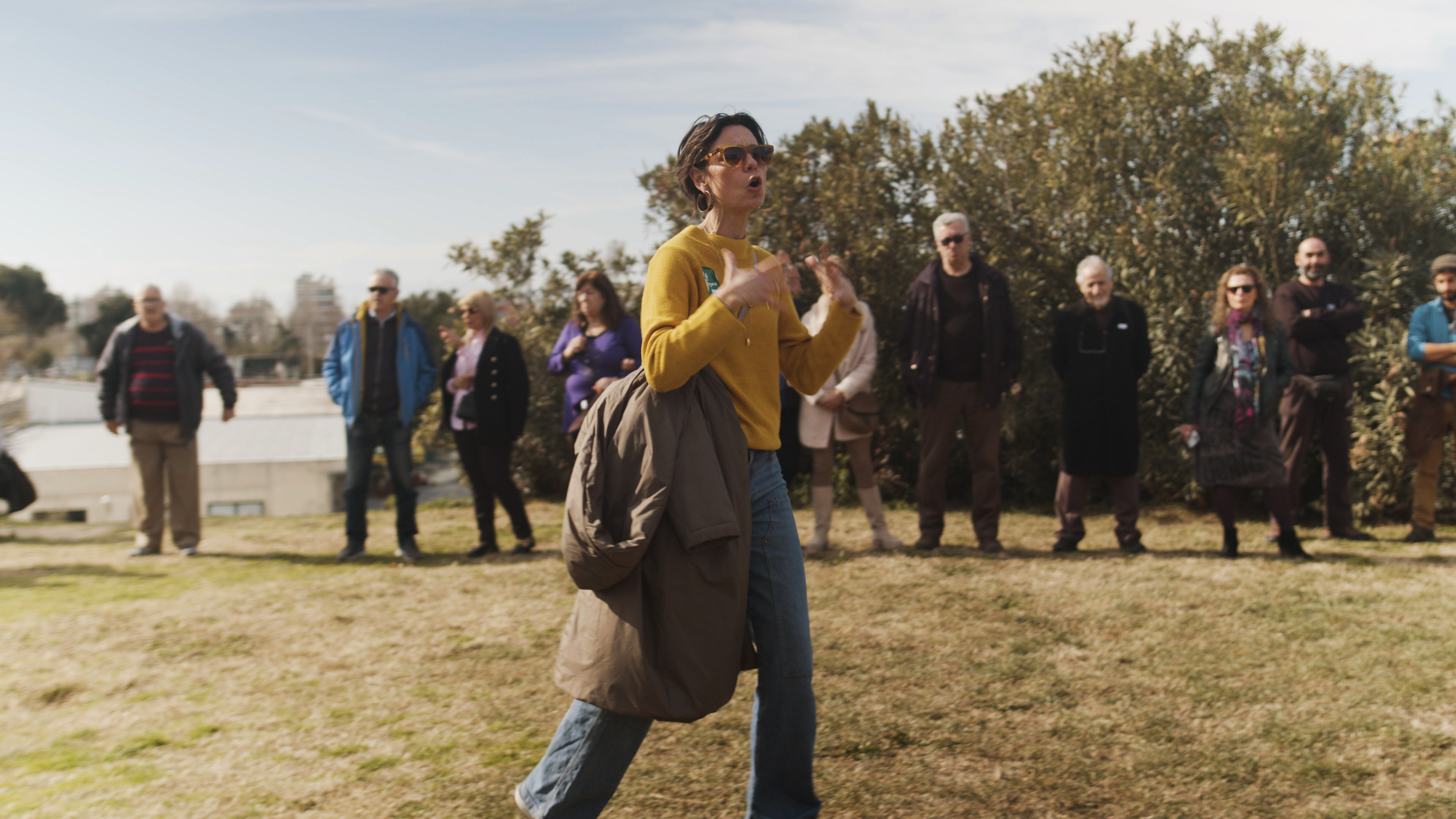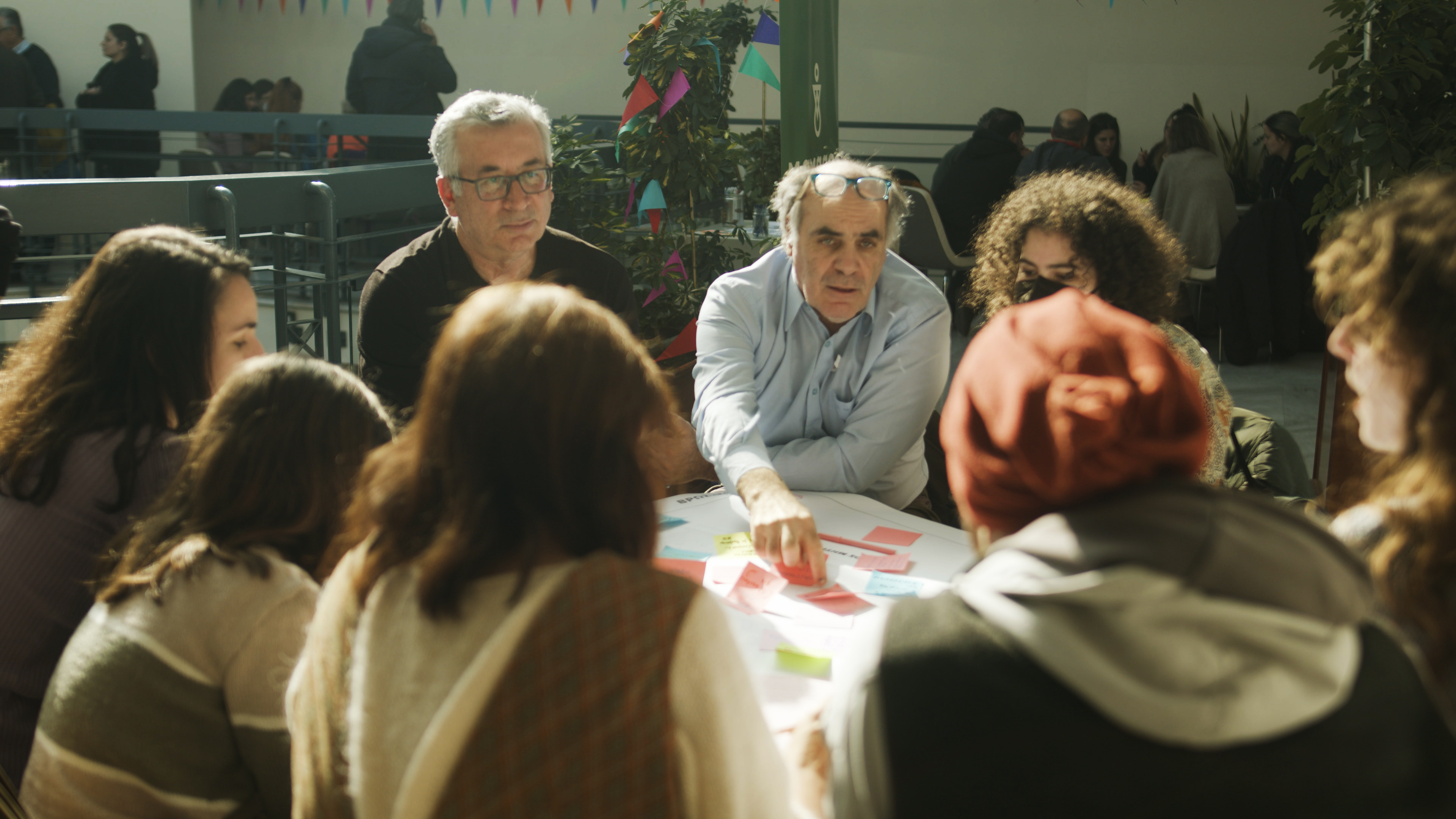Reconnecting with nature
Neapolis Food Forest
Neapolis Food Forest: The co-creation of the first urban food forest in Greece
The Neapolis Food Forest is Greece’s first urban food forest, transforming 1.2m² of barren land into a vibrant, sustainable green space. Co-created by schools, residents, civil society organizations and local authorities, the project promotes climate education, biodiversity, and community resilience. A living example of collaborative urban regeneration, it fosters environmental stewardship and reconnects people with nature, setting an exemplary model for sustainable urban transformation!
Greece
Local
Municipality of Neapoli-Sykies, Thessaloniki
Mainly urban
It refers to a physical transformation of the built environment (hard investment)
Yes
2024-12-30
Yes
EU Staff Fund for a Fair and Sustainable Future, 2023-2024
No
No
As a representative of an organisation, in partnership with other organisations
The Neapolis Food Forest reconnects school communities & citizens with nature through Greece’s first urban food forest. Implemented under ‘Green Sustainable Paths’, it was funded by the EU Staff Fund for a Fair and Sustainable Future & municipal resources. Led by Mamagea in partnership with the Municipality of Neapolis-Sykies and Cob.gr, it transformed 1.2m² of abandoned land—once a landfill—into a thriving agroecological space, reaching over 600 citizens aged 6-76. Located in Neapoli, Thessaloniki, where per capita green space is only 2.74 m² (far below the WHO’s 9 m² recommendation), the project tackles biodiversity loss, education gaps, and limited green areas. In its first year (Dec 23-24), it planted over 750 food-productive trees & plants of at least 50 species, engaged 250 young people in climate education, & held 42h of workshops at the 5th Neapolis High School, where students formed the POAN environmental group. 450 residents co-created the space, supported by 25 municipal employees trained in regenerative agriculture. A volunteer network sustains engagement, while key infrastructure—including a wooden kiosk, fencing built by a vocational training center for people with disabilities, and step-free entry points—enhances accessibility. The project embodies New European Bauhaus values: beautiful, sustainable, and inclusive. Through multi-stakeholder participation & public-commons partnerships, it bridges disciplines from urban planning to education and agronomy. The documentary ‘Cracks of Green’, premiering at the 27th Thessaloniki International Documentary Festival, amplifies its international impact, while interest from other municipalities hints at wider replication. Ultimately, the Neapolis Food Forest improves local communities’ lives by serving as a unique hub for intergenerational climate education, co-created by and for its community, extending the cemented limits of schoolyards into a communal green space of regeneration and reconnection with nature.
Regenerative urban agriculture
Food forest
Nature-Based Solutions
Biodiversity
Education for climate change
Neapolis’ Food Forest is an exemplary model of environmental sustainability, transforming a degraded landfill into a thriving Nature-Based Solution (NBS) that reconnects people with nature while actively combating biodiversity loss, mitigating climate impacts such as the urban heat island effect, and promoting permaculture as an accessible, ecosystemic approach. By regenerating 1.2m² of barren land, the Neapolis’ Food Forest acts as a self-sustaining living organism that enhances soil health, water retention, and carbon sequestration, reducing urban heat and pollution while fostering local biodiversity through features such as pollinator habitats and bee hotels. A key objective of the project has been to integrate environmental sustainability with community engagement. By involving the school community of the 5th Neapolis High School in every stage of its creation, the project serves as a model for co-created public NBS, foregrounding the role of education in addressing the climate crisis. It also pioneers a scalable methodology for urban rewilding in Greece, combining interdisciplinary expertise with low-impact, regenerative land-use strategies. This aligns with Thessaloniki’s commitment as an EU Mission City, positioning the city as a hub for climate innovation and experimentation toward climate neutrality by 2030. As a replicable model, the project proves that even degraded urban spaces can be transformed into self-sustaining ecosystems that restore natural cycles, prevent biodiversity loss, and advance EU zero-pollution and climate adaptation goals. As an innovative case study, it provides a scalable blueprint for integrating green infrastructure into dense urban areas, proving that urban regeneration through Nature-Based Solutions is both feasible and essential to foster human-nature connections towards long-term climate resilience and ecological restoration.
The Neapolis Food Forest transformed a former landfill of Strebeniotis into a dynamic ‘place’ of beauty, connection, and cultural expression. Designed as three concentric circles—evoking a growing ‘hug’ that fits everyone within it—the trees and plants’ layout invites everyone to find their place within it. At the Food Forests’ heart, a wooden kiosk serves as a welcoming hub, drawing people from diverse backgrounds to pause and experience the landscape. The project enhances aesthetic and experiential quality through regular community-driven activities such as planting days, storytelling sessions, community kitchens, art workshops, and educational events. These activities foster shared experiences and cultural exchange while celebrating local heritage through art displays and traditional storytelling. Notably, the Neapolis Food Forest has contributed in transforming many children’s view of soil—from something ‘dirty’ to a vital, life-sustaining resource—underscoring a shift in environmental awareness that is central to the project’s impact. As seasons change, the food forest reveals an ever-evolving tapestry of colors, scents, and textures, symbolizing continuous renewal amid the urban environment, thus reconnecting the local community with nature through the changing of seasons. By integrating participatory design, active community involvement, and cultural programming, the Neapolis Food Forest sets a new standard for urban regeneration. It proves that even degraded urban spaces can be transformed into vibrant, inclusive environments that enrich the quality of life, strengthen social bonds, and inspire creativity. As an exemplary model, it demonstrates that urban nature can be activated through shared care and seamlessly woven into the city’s social and emotional fabric—a place that nurtures and inspires all who step into it.
The Neapolis Food Forest is a model of inclusion-by-design, created to be accessible, welcoming, and collectively governed. It transforms an abandoned landfill into a free, open green space available to all, regardless of age, background, or ability. The design follows ‘design for all’ principles with three intuitive circular pathways, seating areas, and a central wooden kiosk that serves as a meeting point for diverse interactions—from open classrooms to casual gatherings, while raised vegetable beds ensure easy access for wheelchair users, the elderly, and those with mobility disabilities. Community activities continuing to date like planting days, storytelling, communal meals, and hands-on workshops foster multigenerational participation and social cohesion. The initiative has also engaged students at risk of school drop-out, sparking their interest in sustainable agriculture and reconnecting them with nature. Inclusive governance has been a core objective too. The project facilitated 42 hours of educational workshops and three participatory design sessions with local residents, municipal employees, and students using sociocratic principles—a peer-governance model based on consent. This collaborative approach has laid the foundation for a co-managed space, with participation from local Open Elderly Care Centers, scouts, Creative Employment Centers for People with Disabilities, and over 10 local schools. In a further commitment to inclusion, the municipality plans in the long-run to donate part of the harvest to the groups that need it most through the municipal social grocery store, staging the project as a landmark for solidarity and social responsibility. As an exemplary initiative, the Neapolis Food Forest demonstrates how urban nature can be transformed into a common good—accessible, participatory, and deeply embedded in community life—rupturing enclosures and setting a new standard for inclusive urban public spaces and reconnection with nature for all.
The Neapolis Food Forest is a successful Public-Commons Partnership empowering citizens to reclaim and shape public space through redesign, regeneration, and reconnecting with nature. Mamagea partnered with local public authorities using a participatory design approach that engaged residents, school communities, and municipal stakeholders from planning to realization. Regular community meetings, workshops, and analog/digital updates ensured all were informed—with targeted outreach to those often marginalized by digital tech, like the elderly. Students from the 5th Neapolis High School played a pivotal role by contributing to design and construction, fostering strong ownership and strengthening bonds between schools and the broader community—especially significant given that children are often sidelined in urban planning. Teachers further extended the impact by organizing open classrooms in the Food Forest, transforming it into a dynamic space where children continue to experience ecological principles firsthand. To date, local residents self-organize to maintain and harvest the forest, embracing a commons-based approach that boosts social cohesion. During the project’s creation, stakeholder input was processed via participatory workshops and collaborative decision-making sessions guided by sociocratic principles, ensuring every voice was heard. The local municipality and social grocery store are incorporating the Food Forest into future projects and fundings, aiming to strengthen its uses as a hub for reconnecting with nature, for climate change education and for learning about sustainable food. This integration empowers grassroots initiatives and steers the project toward community-led ownership, with the ultimate goal of eventually rendering Mamagea redundant. Overall, the Neapolis’ Food Forest is a replicable, inclusive model demonstrating the transformative impact of grassroots involvement on environmental education, urban regeneration, and community resilience.
Neapolis’ Food Forest is a multi-scalar project engaging stakeholders across different levels in different ways, fostering strong local ownership while linking the project to broader sustainability networks. Locally, diverse networks and institutions were engaged. School communities—including the 5th Neapolis High School and additional schools reached via municipal coordination—participated in aspects of the design, tree-planting and environmental education. The municipal social grocery store, the Educational Centre for Vocational Training of People with Disabilities, and local scouts helped create and activate the forest as a shared urban resource. Regular open calls and activities such as collective kitchens, awareness days, and World Environment Day celebrations have sustained the Food Forest as a hub for civic and ecological engagement during and after its creation. While designed for the local neighborhood, participation extended citywide, underscoring its urban relevance while its place-making approach, rooted in local needs, ensures the space remains accessible and adaptable. Regionally and nationally, design and planting plans were developed with the expertise of Cob.gr—a Social Cooperative Enterprise from Nessonas in Larissa with acclaimed permaculture know-how—bolstering the project’s ecological integrity. Interest from mayors in other municipalities highlights the project’s replicability as a model for urban sustainability, while the project also aligns with Thessaloniki’s commitment as a Mission City for climate neutrality by 2030. Internationally, the project's visibility will be enhanced by the documentary "Cracks of Green", capturing its early development. Set to screen at the 27th Thessaloniki International Documentary Festival (06-16 March 2025) and available on the AGORA Doc Market via the Cannes’s digital platform Cinando, aims to inspire cities and communities worldwide to adopt similar Nature-Based Solutions.
The Neapolis Food Forest integrated multiple disciplines—ecology, urban planning, education, social sciences, and design—to create a rich synergy of expertises. Using participatory design methodologies, the project engaged municipal employees, students, and local residents through three workshops that shaped its layout and functionalities. Young people played a pivotal role not only in design but also in outreach, transforming non-formal knowledge into active community engagement. Informal consultations with various municipal departments ensured alignment with local infrastructure, while Cob.gr, the Social Cooperative Enterprise that served as the permaculture expert, guided the project toward sustainable, regenerative practices. The carpentry workshop of the Educational Centre for Vocational Training of People with Disabilities constructed the wooden fencing of the Food Forest, providing practical training and employment opportunities while introducing the skills and abilities that usually remains marginalized into the project. The project generated new knowledge on applying permaculture in a Commons-Publics Partnership approach to regenerate urban land, establishing a model that can inspire similar projects. Communication across stakeholders was intensive and multi-channel—spanning municipal social media, local events, flyers, posters, newsletters, workshops, information meetings and interviews—ensuring smooth communication among all diverse stakeholders. The project successfully bridged disciplines that typically operate separately by linking agronomists with urban planners, educators with social researchers, and artists with policy-makers. Mamagea’s interdisciplinary team played a crucial role in that direction, translating insights into actionable plans. Smooth collaboration was further secured by the explicit identification of the common need to reconnect with nature, forming the basis for collective action across stakeholders.
The project’s innovation lies in pioneering a scalable methodology for urban rewilding and fostering reconnection with nature for and with urban communities by combining interdisciplinary knowledge with low-impact, regenerative land-use strategies. This approach was realized through Greece’s first-ever urban food forest—a groundbreaking Public-Commons Partnership (PCP) orchestrated by Mamagea, which empowers citizens and local communities to collaborate with public authorities. By partnering with the local municipality and the 5th Neapolis High School, the strategic location of the food forest ensures long-term engagement from a broad spectrum of publics—unlike many participatory projects in Greece that typically involve disproportionately more ‘privileged’ groups. In a country where participatory processes and transdisciplinary, intergenerational, and multi-stakeholder collaborations are underdeveloped, the project’s innovative character is evident in its holistic conception, design, and implementation. By breaking down silos among citizens, decision-makers, and experts, it provides a replicable model for transforming urban spaces into inclusive, participatory hubs that address both environmental and social challenges. As an extension of this innovation we can also trace the use of the Neapolis Food Forest as a hub for climate change education, bridging the gap between schools and their extended neighborhoods. This initiative connects school communities with local residents and public urban spaces through the co-creation of a Nature-Based Solution, extending the confined and heavily cemented schoolyards of Greek state schools into vibrant spaces for environmental learning in their neighbourhoods. Consequently, the project not only reconnects urban communities with nature but also integrates continuous environmental education into the formal curriculum, creating a lasting legacy for future generations.
The Neapolis’ Food Forest was developed through a holistic and interdisciplinary methodological approach, integrating participatory design, arts-based and psychopedagogical education for climate change, sociocratic principles, and multi-stakeholder engagement. The project’s foundation was built on Public-Commons Partnerships, aiming to foster collective stewardship of urban green spaces in Thessaloniki. Through participatory design workshops, students, residents and municipal employees co-created the forest’s layout, ensuring the emerging space’s alignment with local needs. Publics-creating methodologies and place-making techniques were further employed to transform the space into a shared, living place for diverse communities to connect through a shared need to take care of their physical environment and urban agriculture. The project, and in particular the educational workshops with the students and the public engagement activities during the planting phase of the forest, employed the arts, using creative expression and multi-sensorial techniques to engage the youth and the broader public in ecological thinking and sustainable practices. Rooted in permaculture and regenerative agriculture, the project facilitates ecological succession, transitioning from barren land to a thriving, productive ecosystem. Sociocratic principles guided decision-making and co-design during the participatory design workshops and the educational activities, striving for horizontal governance and inclusive participation, while multi-stakeholder involvement–including the municipality, schools, social enterprises and local networks– create fruitful conditions for long-term sustainability. By embedding the forest within a commons-based framework, the project established a replicable model for urban regeneration that strengthens social bonds and promotes ecological resilience.
The Neapolis’ Food Forest project offers a replicable and transferable model for urban regeneration and community engagement across diverse contexts. Its strength lies in a methodological approach that integrates participatory design, multi-stakeholder engagement, and publics-creating methodologies. Developed in close collaboration with local schools and municipalities, the project can be ideally replicated in spaces adjacent to schools, provided that schools willing to cooperate and supportive authorities are in place—a model already attracting interest from other municipalities. Key transferable elements include the participatory design process and sociocratic circular methods that ensure inclusive decision-making, alongside an urban regeneration framework promoting sustainable, circular practices and land use. The project’s innovative design and infrastructure—exemplified by the food forest’s layout—offer a blueprint for creating shared public spaces that foster ecological resilience, social cohesion, and reconnection with nature. Moreover, the educational and community engagement model, rooted in permaculture principles and a Public-Commons Partnership, provides a replicable strategy for integrating environmental education into urban settings. This approach enriches the learning experiences of school communities and strengthens connections between residents and public authorities, leaving a legacy of community-led urban renewal. Finally, the documentary Cracks of Green, accepted at the 27th Thessaloniki International Documentary Festival and available on the AGORA Doc Market via Cannes’s Cinando platform, documents the project’s processes & lessons learned, further supporting its transferability. This resource offers valuable insights for cities and communities worldwide looking to prioritize people’s reconnection with nature via adopting similar Nature-Based Solutions, making the Neapolis’ Food Forest a truly exemplary, scalable model for urban sustainability.
Neapolis’ Food Forest addresses global challenges in climate change and the future of food by offering scalable, beautiful, and sustainable local solutions that are inclusive by design. Grounded in both formal and non-formal knowledge across disciplines, the project transforms a degraded urban site into a thriving green ecosystem that leverages nature-based strategies to mitigate the urban heat island effect and enhance biodiversity—critical measures in combating climate change. Simultaneously, by promoting sustainable food production through permaculture, the Food Forest supports urban agriculture, bolsters local food security, fosters community resilience, and reconnects urban communities with nature. A key innovation lies in the project’s educational fabric, particularly through the catalytic involvement of the 5th Neapolis High School community: by engaging students in the project’s conception, design, and implementation, the Food Forest has advanced climate change education, raised awareness of sustainable land use and food systems, and empowered young citizens to act as agents of change, mobilizing intergenerational efforts. The project’s participatory design, multi-stakeholder engagement, and Public-Commons Partnership offer a replicable blueprint for urban regeneration and reconnection with nature adaptable to diverse contexts. Its inclusive methodology—emphasizing low-impact design and sustainable practices—demonstrates how local initiatives can deliver tangible benefits in climate resilience and food sustainability. By aligning with EU EIT KIC’s priorities, the Neapolis’ Food Forest stands as an innovative, community-driven model that addresses pressing global challenges while inspiring broader socio-environmental transformation that starts locally.
The Neapolis Food Forest project has delivered transformative results across direct outputs, outcomes, and long-term impacts. As a direct output, the project co-created Greece’s first urban Food Forest by transforming 1,2 m² of barren land into a vibrant, sustainable, and inclusive green space. Over 750 food-productive trees and plants were planted, and a wooden kiosk was installed as a community gathering point and outdoor educational hub. To date more than 50 stakeholders—including students, teachers, parents, neighbors, municipal officials, Mamagea volunteers, and citizens—actively contribute to its ongoing stewardship. A youth-led environmental group emerged from the 5th Neapolis High School, empowering young people as catalysts for intergenerational change. Three participatory workshops and 42 hours of educational sessions on permaculture, Nature-Based Solutions, and co-management—underpinned by sociocratic methodologies—along with a Memorandum of Collaboration with the Municipality of Neapolis-Sykies, solidified the process, while the creation of a documentary capturing the first months of the project and its subsequent screening at the 27th Thessaloniki International Documentary Festival and extensive media outreach amplified its impact. In the short to medium term, the Food Forest has increased engagement, strengthened community ties, and improved soil quality and vegetation cover, thereby demonstrating the feasibility of NBS in Greek urban settings. In the long term, the project aims to serve as a replicable model for reconnection with nature through participatory urban greening and sustainable food systems, contributing to climate adaptation by reducing the urban heat island effect, improving air quality, and expanding green infrastructure. It also has the potential to shape municipal policies on sustainable land use and community-led NBS, fostering a cultural shift toward a stronger, enduring connection between people and nature.


